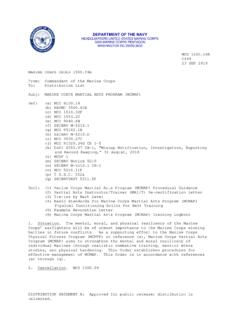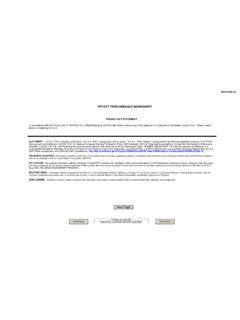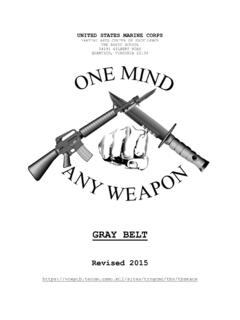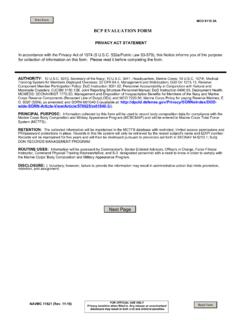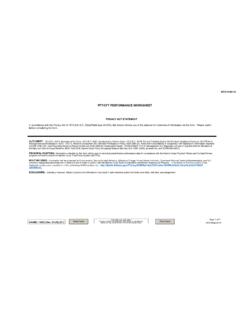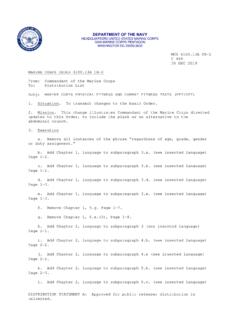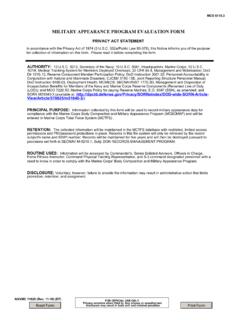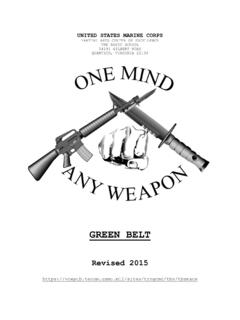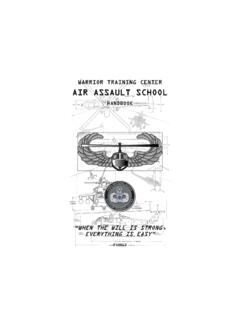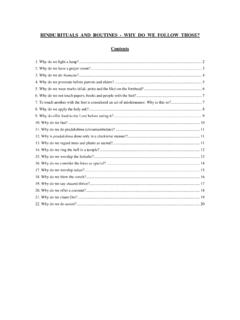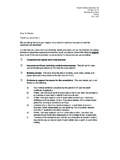Transcription of TAN BELT - fitness.marines.mil
1 UNITED STATES MARINE CORPS MARTIAL ARTS CENTER OF EXCELLENCE THE BASIC SCHOOL 24191 GILBERT ROAD QUANTICO, VIRGINIA 22134 TAN BELT Revised 2015 1 TABLE OF CONTENTS Lesson ID Lesson Title Page # MCCS-TAN-1001 FUNDAMENTALS OF MARINE CORPS MARTIAL MCCS-TAN-1002 MCCS-TAN-1003 BREAK MCCS-TAN-1004 BAYONET MCCS-TAN-1005 UPPER BODY MCCS-TAN-1006 LOWER BODY MCCS-TAN-1007 MCCS-TAN-1008 MCCS-TAN-1009 COUNTERS TO MCCS-TAN-1010 COUNTERS TO CHOKES AND MCCS-TAN-1011 UNARMED MCCS-TAN-1012 ARMED MCCS-TAN-1013 KNIFE MCCS-TAN-1014 WEAPONS OF MCCS-TAN-1015 STRUCTURE AND HISTORY OF MCCS-TAN-1016 RESPONSIBLE USE OF MCCS-TAN-1017 PUGIL STICK MCCS-TAN-1018 BODY GUIDED DISCUSSION 1: MARINE CORPS CORE GUIDED DISCUSSION 2: SEXUAL GUIDED DISCUSSION 3: DRUG GUIDED DISCUSSION 4: EQUAL GUIDED DISCUSSION 5: 2 MCCS-TAN-1001 3 UNITED STATES MARINE CORPS MARTIAL ARTS CENTER OF EXCELLENCE THE BASIC SCHOOL 24191 GILBERT ROAD QUANTICO, VIRGINIA 22134 LESSON PLAN FUNDAMENTALS OF MARINE CORPS MARTIAL ARTS MCCS-TAN-1001 TAN BELT APPROVED BY: LtCol (Ret) Shusko, J.
2 C. DATE: __07/08/2015__ MCCS-TAN-1001 2 UNITED STATES MARINE CORPS MARTIAL ARTS CENTER OF EXCELLENCE THE BASIC SCHOOL 24191 GILBERT ROAD QUANTICO, VIRGINIA 22134 INSTRUCTOR PREPARATION GUIDE LESSON TITLE: Fundamentals of Marine Corps Martial Arts LESSON DESIGNATOR: MCCS-TAN-1001 TOTAL LESSON TIME: 1 hour REFERENCES: MCO NAVMC MCRP 3-02B PERSONNEL REQUIRED: One instructor and assistant FACILITIES: Soft footed training area REVIEW COURSE MATERIALS: Review Lesson Plan ADD PERSONALIZATION: Personalize the lesson by adding subject matter detail, personal experiences, examples, and questions. MATERIALS/EQUIPMENT: None SETUP AND PLANNING: Reserve Training Area Conduct Rehearsals MCCS-TAN-1001 3 INTRODUCTION (5 MIN) 1.
3 GAIN ATTENTION. There are several fundamentals of the physical discipline in our martial arts used throughout any type of confrontation or situation. These fundamentals form the basis for all martial arts instruction and techniques. The proper execution of these fundamentals will enable you to effectively perform martial arts techniques that may save your life or the lives of fellow Marines. 2. OVERVIEW. Good morning, my name is _____. This lesson will cover the fundamentals of MCMAP and the mental and character disciplines of MCMAP. 3. POSITIONS 4. SAFETY. To prevent injury, ensure the following: a. Start slowly and increase speed with proficiency. b. Techniques will be performed on a soft-footed area. TRANSITION. Now that you know what will be covered are there any questions? Let s discuss the purpose of MCMAP. BODY (45 MIN) 1.
4 EXPLAIN a. Purpose. The purpose of the Marine Corps Martial Arts Program is to execute unarmed and armed techniques to use lethal and non-lethal force across a spectrum of violence. (1) Unarmed techniques include hand-to-hand combat and defense against hand-held weapons. (2) Armed techniques include techniques applied with a rifle, pistol, knife, or weapon of opportunity. b. Principles. The principles of MCMAP are the ranges of close combat, the weapons of the body, and the target areas of the body. (1) Ranges of Close Combat. There are three ranges in which close combat engagements can take place: long range, mid-range, and close range. In any engagement, these ranges may blur INSTRUCTOR NOTE: Assign demonstration and practice positions. Ensure students have enough space, and can see and hear the instructor. MCCS-TAN-1001 4 together or may rapidly transition from one to another and then back again until the aggressor is defeated or the situation is handled.
5 (a) Long Range. At long range, the distance between combatants allows engagement with a rifle, bayonet, or weapon of opportunity. (b) Mid-Range. At mid-range, the distance between combatants is such that they can engage each other with knives, punches, or kicks. (c) Close Range. At close range, the distance between combatants is such that they can grab a hold of each other and may involve elbow and knee strikes and grappling. (2) Weapons of the Body. The weapons of the body are divided into two groups: the arms and legs. (a) Arms. The arms are the most commonly used weapons of the body, consisting of the hands and elbows. 1. Hands. The hands are the instant response weapon of the body. They can be used for striking, choking, grabbing, and wielding a weapon. 2.
6 Elbows. The elbows do not have all the functions of the hands, but they can deliver more force at close range. The striking surface is also stronger because the bones of the elbows are larger and harder than those in the hands. (b) Legs. The legs are considered the most powerful weapon of the body, consisting of the feet and knees. 1. Feet. The feet are not easily employed and require training, coordination, and skill to be used as a weapon. They can be used for kicks and stomps to generate more power than strikes with the arms. The shins may also be utilized as a striking surface. 2. Knee. The largest amount of power can be delivered from knee strikes. Knee strikes are most effective while fighting close to your aggressor where kicks are impractical. (3) Target Areas of the Body. During close combat, the parts of the aggressor's body readily accessible will vary with each situation and throughout a confrontation.
7 The goal is to attack those areas that are easily accessible and will cause damage to the aggressor. These areas are divided into five major groups: head, neck, torso, groin, and extremities. MCCS-TAN-1001 5 1. Head. The vulnerable regions of the head are the eyes, temple, nose, ears, and jaw. Massive damage to the skull can kill an aggressor. 2. Neck. The entire neck is vulnerable because it contains vital blood vessels, the trachea, and the upper portion of the spine. 3. Torso. The vulnerable areas of the torso are the clavicle, solar plexus, and internal organs. 4. Groin. The groin area is a very sensitive target area made of soft tissue. This is a good target area because it contains large arteries and nerves. An attack can be quickly debilitating for both genders. 5. Extremities.
8 The arms and legs are important target areas because they are the aggressor s weapons. Attacks will not usually cause death but can lead to loss of motor function of the extremity. c. Fundamentals. The basic fundamentals for the Marines Corps Martial Arts Program are the basic warrior stance and angles of movement. (1) Basic Warrior Stance. The basic warrior stance provides the foundation for all movement and techniques in close combat situations. Marines must be able to assume the basic warrior stance instinctively. All movement should start and stop in the basic warrior stance. (2) Angles of Movements. The worst place to be in a confrontation is directly in front of an aggressor. Movement makes different target areas available, enables the use of different techniques, and increases power. Moving at a 45-degree angle is the best way to avoid and aggressor s strike and gain the advantage.
9 TRANSITION: We have covered the purpose, principles, and fundamentals, are there any questions? I will now demonstrate the first technique. 2. DEMONSTRATE INTERIM TRANSITION: Go to practice position one. 3. IMITATE INSTRUCTOR NOTE: Demonstrate only one technique at a time. Do not explain the steps or open the class for questions. MCCS-TAN-1001 6 a. Basic Warrior Stance. (1) Place your feet shoulder width apart, take a half step forward with your left foot, and turn your hips and shoulders approximately 45-degree angle to the right. (2) Distribute your body weight evenly by bending the knees slightly and adjusting your feet in order to maintain your balance. (3) Loosen your fists and bring your hands up to chin level or high enough to protect the head without obstructing your vision. (4) Tuck your elbows in close to your body to protect your body.
10 (5) Tuck your chin down to take advantage of the natural protection provided by your shoulders. b. Angles of Movement. There are eight angles of movement that can be executed in 360 degrees around an aggressor. (1) Forward. Move the left foot forward approximately 12 to 15 inches. As soon as the left foot is in place, quickly step with the right foot 12-15 inches returning to the basic warrior stance. Xopponent MCCS-TAN-1001 7 (2) Backward. Move the right foot backward approximately 12-15 inches. As soon as the right foot is in place, quickly bring the left foot in front of the right foot to return to the basic warrior stance. (3) Left. Move the left foot to the left approximately 12 to 15 inches. As soon as the left foot is in place, quickly bring the right foot behind the left foot to return to the basic warrior stance.
